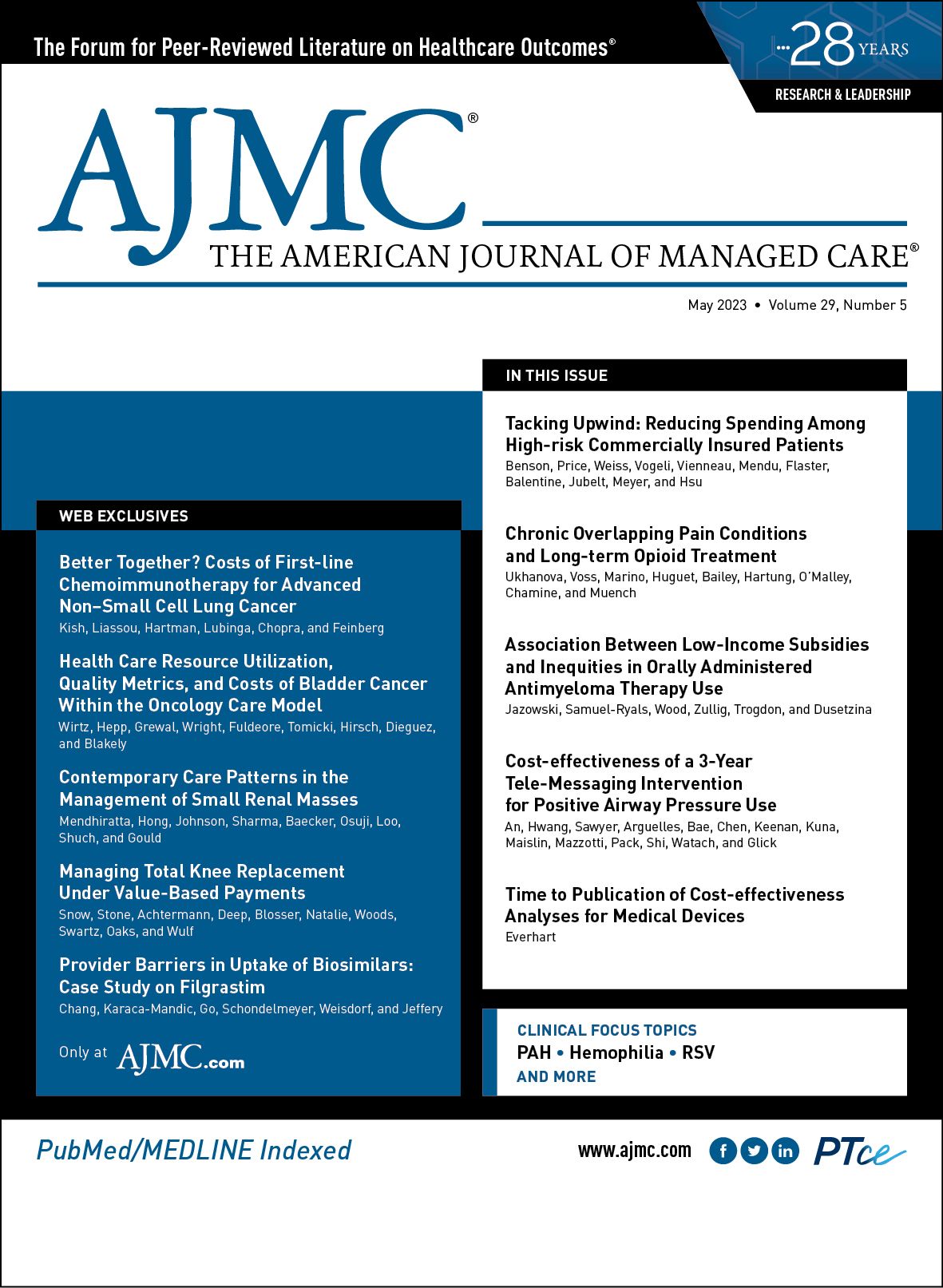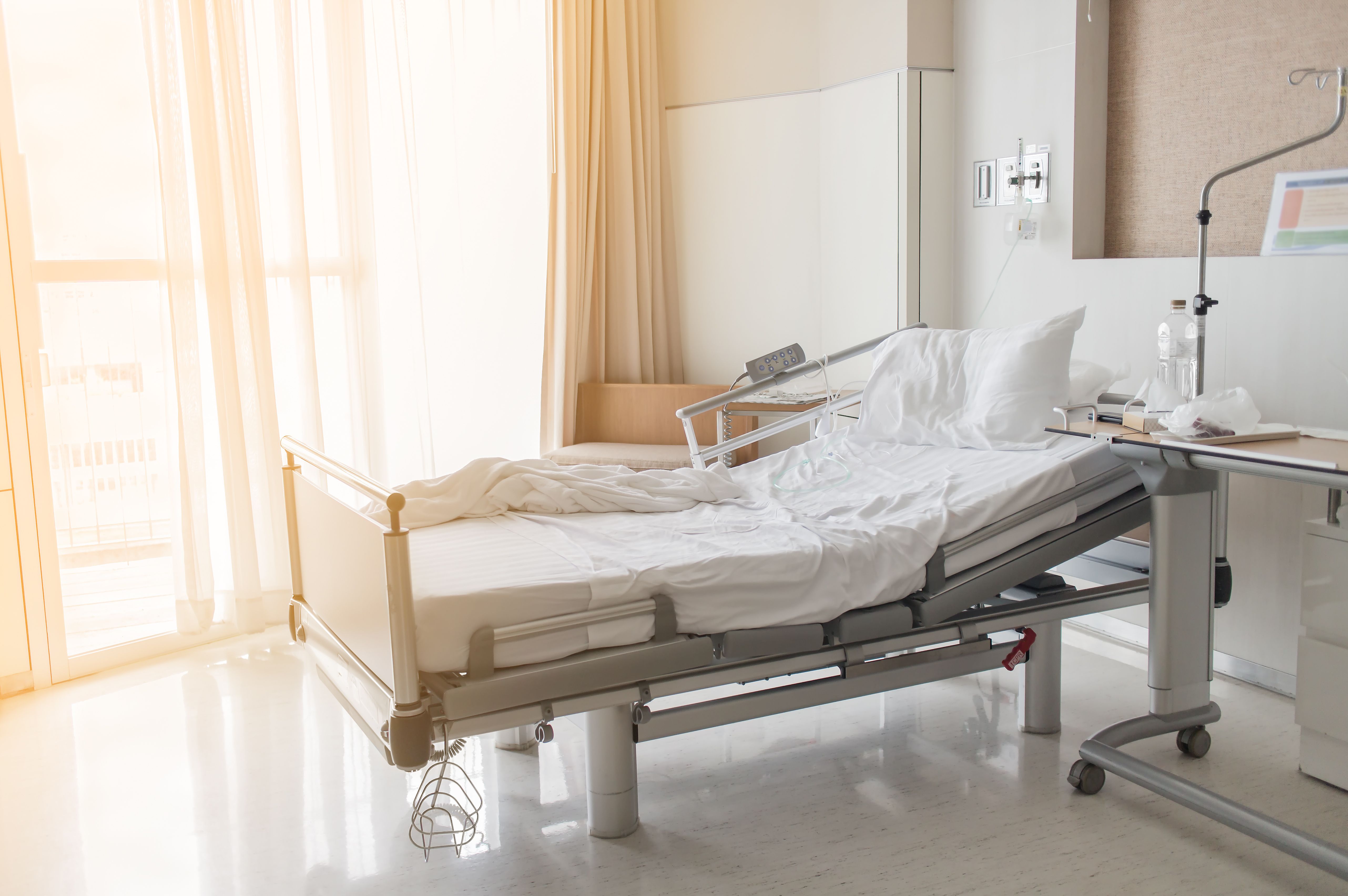Publication
Article
The American Journal of Managed Care
Provider Barriers in Uptake of Biosimilars: Case Study on Filgrastim
Author(s):
Previous studies have found modest uptake of biosimilars in both commercial and Medicare populations. This study finds that the uptake varies between the rural and urban provider settings.
ABSTRACT
In this article, we used administrative claims data from the OptumLabs Data Warehouse and American Hospital Association Annual Survey data to examine associations between hospital characteristics and uptake of biosimilar granulocyte colony-stimulating factor treatments. We found that 340B-participating hospitals and non–rural referral center (RRC) hospitals that reported owning rural health clinics were less likely to administer the lower-cost biosimilars, whereas the opposite was true for hospitals that are RRCs. To our knowledge, our study offers a first look at an underappreciated source of disparities in access to lower-cost medications such as biosimilars. Results from our study reveal opportunities for targeted policies to encourage adoption of lower-cost treatments, particularly among hospitals that serve rural communities where patients often have fewer choices in care site.
Am J Manag Care. 2023;29(5):e155-e158. https://doi.org/10.37765/ajmc.2023.89363
Takeaway Points
Biosimilars are intended to increase competition, reduce prices, and improve patient access to important treatments. The first FDA-approved biosimilar was launched in 2015: Filgrastim-sndz (Zarxio), a biosimilar for the reference drug filgrastim (Neupogen), is a granulocyte colony-stimulating factor used to prevent and treat neutropenia.
- Rural and 340B-participating hospitals were less likely to use biosimilar filgrastim than urban and non-340B hospitals, respectively.
- Patients seen in rural and 340B hospitals may have fewer choices for receiving care close to home, limiting their ability to choose lower-cost treatment options.
Filgrastim-sndz (Zarxio), a granulocyte colony-stimulating factor (G-CSF) used to prevent and treat neutropenia, was the first biosimilar drug to receive FDA approval, launching in September 2015 as a biosimilar to the originator product, Neupogen. Before the biosimilar pathway was available, tbo-filgrastim (Granix) was approved under a full Biologics License Application in 2012 and launched in November 2013. Uptake of biosimilars in the United States has been modest vs in Europe despite the lower prices of biologics compared with originators.1,2 As more biosimilars enter the market, understanding hospital variation in uptake will be important to allow policy makers to improve policies to encourage use of lower-cost versions of these often very expensive drugs.3 Because 340B-participating hospitals, rural hospitals, and hospitals with rural service lines disproportionately treat vulnerable patient populations with known health disparities, higher poverty rates, and lower incomes, it is important to identify factors associated with variation in uptake of lower-cost drugs.4 In this study, we examined the association between hospital characteristics and uptake of biosimilar filgrastim and tbo-filgrastim among Medicare Advantage (MA) enrollees.
METHODS
We identified episodes of use of short-acting filgrastim (originator, biosimilar, and tbo-filgrastim) among MA enrollees between September 2015 and May 2020 from the OptumLabs Data Warehouse, which contains longitudinal, deidentified pharmacy and medical claims data for enrollees across the United States.5 We used claims information to classify each episode as a chemotherapy regimen with a high risk of neutropenia (classified by National Comprehensive Cancer Network guidelines),6 stem cell transplant, or other. We limited the cohort to individuals with 6 or more months of continuous enrollment in medical and pharmacy benefits prior to the index date. Patient demographic information assessed as of the index date included age, sex, and Charlson comorbidities assessed as binary flags for each condition measured over the 6 months prior to the episode start. We excluded episodes with multiple filgrastim products or unknown patient sex. We constructed patient covariates such as Charlson comorbidity flags based on claims prior to the filgrastim use episode and likely reason for filgrastim use, such as high-risk chemotherapy, stem cell transplant, or other. We ascertained hospital characteristics with data from the American Hospital Association survey and the Health Resources and Services Administration, including bed counts, 340B program participation, and CMS rural facility designations. We created a measure of the relative intensity of the use of biologic drugs for each hospital. We constructed a ratio of the number of patient-service dates that included the use of any biologic drug to the total number of patient-service dates observed for each hospital. The biologic intensity variable is a binary variable indicating whether the hospital was at or above the 90th percentile on that measure.
We used 2 separate measures to identify rurality. The first was whether a hospital is designated as a rural referral center (RRC), which is a rural hospital that serves a high share of complex patients. The second measure was whether a hospital is not an RRC but owns a CMS-certified rural health clinic (RHC), which is paid by Medicare under a different reimbursement schedule for clinics that provide primary care services to rural communities. We classified hospitals into 3 categories: RRC hospitals, non-RRC hospitals that own an RHC, and nonrural hospitals (that is, non-RRC hospitals that do not own an RHC). RRCs that are not owned by for-profit corporations and that serve low-income patients (ie, a disproportionate share adjustment percentage of at least 8%) are eligible to participate in the 340B program.
We modeled the association between uptake characteristics and drug choice at the patient-episode level, using multinomial logit regression with clustered SEs (at the patient level), adjusting for patient and hospital characteristics. We calculated predictive margins (ie, adjusted proportions of patients receiving each drug) to ease interpretation of model results.
RESULTS
Our study included 17,637 episodes, of which 83.6% were seen in nonrural hospitals and 70.8% were seen in 340B hospitals (Table7). We found no clinically significant differences by patient characteristics (eg, comorbidities, sex) in the choice of filgrastim originator, biosimilar, and tbo-filgrastim, which accounted for 38.9%, 34.0%, and 27.1% of all episodes, respectively. Hospital characteristics such as bed count were associated with differences in filgrastim choice, with hospitals with 400 or more beds being 70% more likely to administer biosimilar filgrastim and about half as likely to administer tbo-filgrastim compared with those with less than 200 beds. Complete results from the multinomial logit model are presented in the eAppendix (available at ajmc.com).
Based on the adjusted proportions from the multinomial logit model, patients seen in 340B-participating hospitals were 9.8 percentage points less likely than those seen in non-340B hospitals to receive potentially lower-priced alternatives such as biosimilar filgrastim and tbo-filgrastim (rate of nonoriginator filgrastim use in 340B-participating hospitals vs non–340B-participating hospitals: 58.1% vs 67.9%; P < .001) (Figure, panel A).
Among episodes of nonoriginator filgrastim use, 340B hospitals were more likely to use biosimilar filgrastim than tbo-filgrastim (biosimilar was used in 59.7% of nonoriginator episodes in 340B hospitals vs 48.2% in non-340B hospitals; P < .001).
Patients treated at non-RRC hospitals that own an RHC were the least likely to receive biosimilar or tbo-filgrastim (40.6%), whereas those treated at RRC hospitals (65.2%) and nonrural hospitals (63.6%) had similar rates of biosimilar or tbo-filgrastim receipt (P = .61 for comparison of RRC vs nonrural hospitals; P < .001 for comparison of non-RRC hospitals that own an RHC vs RRC hospitals) (Figure, panel B).
DISCUSSION
Results from our study on G-CSF episodes found that 340B hospitals were less likely to administer the lower-cost biosimilar or tbo-filgrastim. Certain rural hospitals were also less likely to administer lower-cost versions of filgrastim; episodes of care at non-RRC hospitals that own RHCs were more than 20 percentage points less likely to include the use of biosimilar or tbo-filgrastim than larger RRC hospitals or nonrural hospitals. Rural hospitals’ small size and relatively low volume compared with their urban counterparts may give them less flexibility to offer both originator and biosimilar drugs to patients. Reimbursement policies for 340B and other hospitals may incentivize use of more expensive originator drugs. For example, Medicaid classifies biosimilars as a single-source drug under the mandatory manufacturer rebate, which makes the value of the originator rebate higher than for the biosimilar, reducing incentives to switch to a biosimilar for those patients and creating a spillover effect for other patients.8
Limitations
This study is limited to individuals with MA insurance and may not represent the experience of those with Medicaid or traditional Medicare seen in the same hospitals. We do not observe the prices that hospitals pay to acquire drugs, which may be lower for originator biologics than for biosimilars at some hospitals; however, in prior work we identified lower insurer- and patient-paid amounts for biosimilar compared with originator filgrastim.1
CONCLUSIONS
In this study, we offer a first look at an underappreciated source of disparities in access to lower-cost biologic drugs. Individuals living in rural areas, including a significant proportion of Americans 65 years and older,9 may have fewer choices of hospitals than those living in urban areas, and they typically seek care in hospitals with RRC or RHC designations. Without access to lower-cost biosimilars, they may end up paying more for some high-cost treatments. As more biosimilars enter the market, results of our study reveal opportunities for targeted policies to encourage adoption of lower-cost treatments, particularly among hospitals treating older patients with fewer choices in care site.
Author Affiliations: OptumLabs Visiting Fellow (JC, MMJ), Eden Prairie, MN; University of Minnesota School of Public Health (JC), Minneapolis, MN; National Bureau of Economic Research (PK-M), Cambridge, MA; University of Minnesota Carlson School of Management (PK-M), Minneapolis, MN; Mayo Clinic (RSG, MMJ), Rochester, MN; University of Minnesota College of Pharmacy (SS), Minneapolis, MN; University of Minnesota Medical School (DW), Minneapolis, MN.
Source of Funding: American Cancer Society (RSGI-17-154-01-CPHPS).
Author Disclosures: Dr Karaca-Mandic is the principal investigator and Dr Jeffery is a coinvestigator of the American Cancer Society grant that funded this study. Dr Karaca-Mandic also reports receipt of unrelated personal fees from Koya Medical and Mayo Clinic; receipt of unrelated grants from the Agency for Healthcare Research and Quality, the National Institute for Health Care Management, the National Institute on Drug Abuse/National Institutes of Health, the Robert Wood Johnson Foundation, and the United Health Foundation; and serving in an executive position and holding equity in XanthosHealth LLC, which is developing health information technology in oncology; Dr Karaca-Mandic’s interests have been reviewed and managed by the University of Minnesota in accordance with its Conflict of Interest policies. Dr Weisdorf reports receiving research support from FATE and Incyte and receiving lecture fees for a presentation on graft-vs-host disease, all outside this work. The remaining authors report no relationship or financial interest with any entity that would pose a conflict of interest with the subject matter of this article.
Authorship Information: Concept and design (JC, PK-M, RSG, SS, DW, MMJ); acquisition of data (JC, PK-M, MMJ); analysis and interpretation of data (JC, PK-M, RSG, SS, DW, MMJ); drafting of the manuscript (JC, PK-M, RSG, MMJ); critical revision of the manuscript for important intellectual content (JC, PK-M, RSG, SS, DW, MMJ); statistical analysis (JC, PK-M, MMJ); obtaining funding (PK-M, MMJ); and administrative, technical, or logistic support (JC).
Address Correspondence to: Jessica Chang, MA, University of Minnesota School of Public Health, 420 Delaware St SE, Minneapolis, MN 55455. Email: chan1576@umn.edu.
REFERENCES
1. Karaca-Mandic P, Chang J, Go R, Schondelmeyer S, Weisdorf D, Jeffery MM. Biosimilar filgrastim uptake and costs among commercially insured, Medicare Advantage. Health Aff (Millwood). 2019;38(11):1887-1892. doi:10.1377/hlthaff.2019.00253
2. Chen AJ, Ribero R, Van Nuys K. Provider differences in biosimilar uptake in the filgrastim market. Am J Manag Care. 2020;26(5):208-213. doi:10.37765/ajmc.2020.42786
3. Nabhan C, Parsad S, Mato AR, Feinberg BA. Biosimilars in oncology in the United States: a review. JAMA Oncol. 2018;4(2):241-247. doi:10.1001/jamaoncol.2017.2004
4. National Healthcare Quality and Disparities Report: chartbook on rural healthcare. Agency for Healthcare Research and Quality publication No. 22-0010. November 2021. Accessed May 3, 2022. https://www.ahrq.gov/sites/default/files/wysiwyg/research/findings/nhqrdr/chartbooks/2019-qdr-rural-chartbook.pdf
5. Wallace PJ, Shah ND, Dennen T, Bleicher PA, Crown WH. Optum Labs: building a novel node in the learning health care system. Health Aff (Millwood). 2014;33(7):1187-1194. doi:10.1377/hlthaff.2014.0038
6. NCCN. Clinical Practice Guidelines in Oncology. Prevention and treatment of cancer-related infections, version 2.2020. Accessed May 3, 2022. https://www.nccn.org/professionals/physician_gls/pdf/infections.pdf
7. Quan H, Sundararajan V, Halfon P, et al. Coding algorithms for defining comorbidities in ICD-9-CM and ICD-10 administrative data. Med Care. 2005;43(11):1130-1139. doi:10.1097/01.mlr.0000182534.19832.83
8. Lyman GH, Balaban E, Diaz M, et al. American Society of Clinical Oncology statement: biosimilars in oncology. J Clin Oncol. 2018;36(12):1260-1265. doi:10.1200/JCO.2017.77.4893
9. Smith AS, Trevelyan E. The older population in rural America: 2012-2016. US Census Bureau. September 2019. Accessed May 3, 2022. https://www.census.gov/content/dam/Census/library/publications/2019/acs/acs-41.pdf






